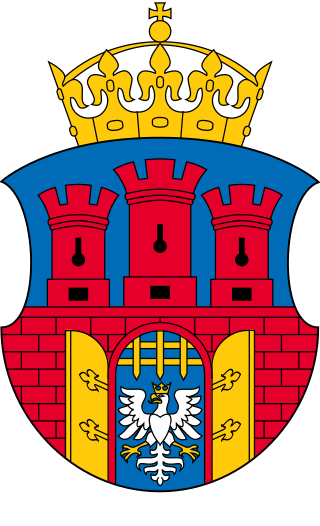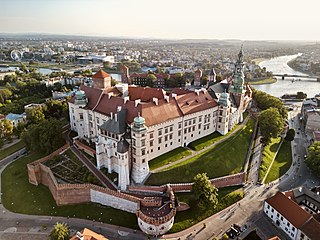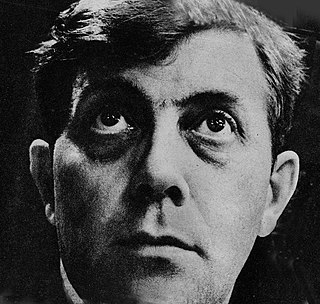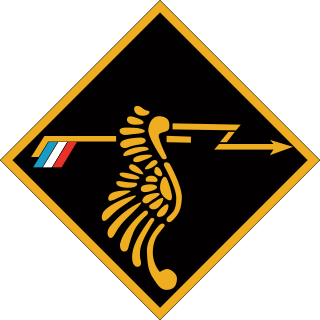Kraków Gate may refer to:
Kraków Gate may refer to:

Arbeit macht frei ( ) is a German phrase translated as "Work makes one free" or more idiomatically "Work sets you free" or "work liberates".

Kraków(Polish:[ˈkrakuf] ), also spelled as Cracow or Krakow, is the second-largest and one of the oldest cities in Poland. Situated on the Vistula River in Lesser Poland Voivodeship, the city has a population of 804,237 (2023), with approximately 8 million additional people living within a 100 km (62 mi) radius. Kraków was the official capital of Poland until 1596, and has traditionally been one of the leading centres of Polish academic, cultural, and artistic life. Cited as one of Europe's most beautiful cities, its Old Town was declared a UNESCO World Heritage Site in 1978, one of the world's first sites granted the status.

A city gate is a gate which is, or was, set within a city wall. It is a type of fortified gateway.

A barbican is a fortified outpost or fortified gateway, such as at an outer defense perimeter of a city or castle, or any tower situated over a gate or bridge which was used for defensive purposes.
Kraków Voivodeship may also refer to:

Nowa Huta is the easternmost district of Kraków, Poland. With more than 200,000 inhabitants, it is one of the most populous areas of the city. Until 1990, the neighbouring districts were considered expansions of the original Nowa Huta district, and were linked by the same tramway system. They are now separate districts of Kraków.

The city of Kraków uses a coat of arms, a seal, official colors, a flag, and a banner as its official symbols. Additionally, a number of semi-official and unofficial symbols of the city are also used.

St. Mary's Trumpet Call is a traditional, five-note Polish bugle call closely bound to the history and traditions of Kraków. It is played every hour on the hour, four times in succession in each of the four cardinal directions, by a trumpeter on the highest tower of the city's Saint Mary's Basilica. The noon performance is broadcast via radio to all of Poland and the world.

The Wawel Royal Castle and the Wawel Hill on which it sits constitute the most historically and culturally significant site in Poland. A fortified residency on the Vistula River in Kraków, it was established on the orders of King Casimir III the Great and enlarged over the centuries into a number of structures around an Italian-styled courtyard. It represents nearly all European architectural styles of the Medieval, Renaissance and Baroque periods.

The Kraków Barbican is a barbican – a fortified outpost once connected to the city walls. It is a historic gateway leading into the Old Town of Kraków, Poland. The barbican is one of the few remaining relics of the complex network of fortifications and defensive barriers that once encircled the royal city of Kraków in the south of Poland. It currently serves as a tourist attraction and venue for a variety of exhibitions.

The Gothic architecture arrived in Poland in the first half of the 13th century with the arrival of the Dominican and Franciscan orders. The first elements of the new style are evident in the foundation of the Dominican Trinity church in Kraków (1226–1250), built by Bishop Iwo Odrowąż. Rebuilding of the Wrocław Cathedral, started in 1244, was another early manifestation of the Gothic style. The earliest building in Poland built entirely in the Gothic style is the chapel of St. Hedwig in Trzebnica (1268–1269), on the grounds of a Cistercian monastery.

St. Florian's Gate or Florian Gate in Kraków, Poland, is one of the best-known Polish Gothic towers, and a focal point of Kraków's Old Town. It was built about the 14th century as a rectangular Gothic tower of "wild stone", part of the city fortifications against Tatar attack.

Wiktor Zin was a Polish architect, graphic artist, professor, architectural preservationist, cultural activist, and promoter of Polish history and culture.

The city of Kraków is divided into 18 administrative districts, each with a degree of autonomy within the municipal government. The Polish name for such a district is dzielnica.

No. 308 "City of Kraków" Polish Fighter Squadron RAF was a Polish fighter squadron formed in Great Britain as part of an agreement between the Polish Government in Exile and the United Kingdom in 1940. It was one of 15 squadrons of the Polish Air Force in exile that served alongside the Royal Air Force in World War II.

The New Jewish Cemetery is a historic necropolis situated on 55 Miodowa Street in Kraków, Poland. Located in the former Jewish neighborhood of Kazimierz, it covers an area of about 4.5 hectares. Since 1999, the cemetery is a registered heritage monument. The grounds also feature a well-preserved mortuary.

The Kraków-Kolna Canoe Slalom Course is an artificial whitewater course in Poland, on the south bank of the Vistula River, in the suburb of Kolna, 10 kilometres (6 mi) west of Kraków. It is fed with river water diverted around a nearby dam. The top 120 metres (394 ft) of the course is a flatwater start pool that is covered in winter by a long white tent. Air inside the tent is heated, but the water is cold.

Floriańska Street or St. Florian's Street is one of the main streets in Kraków Old Town and one of the most famous promenades in the city. The street forms part of the regular grid plan of Stare Miasto, the merchants' town that extends the medieval heart of the city, which was drawn up in 1257 after the destruction of the city during the first Mongol invasion of Poland of 1241.
Dragon Gate may refer to:

The Free City of Krakow is a 1985 post-apocalyptic military tabletop role-playing game adventure for Twilight: 2000 published by Game Designers' Workshop (GDW).